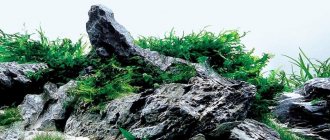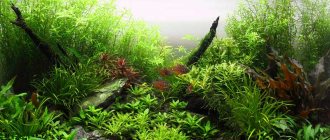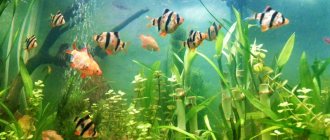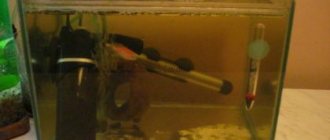When choosing plants for a freshwater aquarium, you should pay special attention to the planting location of one or another representative of the flora. Conventionally, there are three main plans in the aquarium: front, middle and back. For each of them, certain plants are suitable, which will be able to fully grow and develop in “their place.”
The most capricious and complex are the foreground plants. These are, as a rule, low-growing plants that form a dense “carpet” over time. Some of them remain low throughout the growing season, while some need pruning to maintain their decorative appearance. What they all have in common are increased requirements for conditions of detention:
- The soil needs to be fine, rich in nutrients, loose
- Soft, slightly acidic water
- Regular mineral fertilizing of water and roots
- Supplying carbon dioxide to the aquarium
- Bright lighting (at least 0.8-1 W / liter) for 8-10 hours
Their appearance (color saturation, shape), growth rate and life expectancy depend on the conditions in which these plants are kept. When creating favorable conditions in a home aquarium, ground cover plants will delight their owner for a long time!
Brazilian lileopsis (Lilaeopsis brasiliensis)
Lileopsis is a lawn-like, slow-growing plant from the Apiaceae family. The homeland of lileopsis is the reservoirs of South America.
Lileopsis has a short stem with thin, long green leaves, and a well-developed root system.
This low-growing grass, growing about 5 cm in height, forms a dense carpet on the bottom of the aquarium.
Marsilia quatrefoil
Marsilea quadrifolia is a fern plant characterized by slow growth . This quality is especially valuable for small aquariums. But, the plant is grown in the foreground in containers of any size.
The sheet of original shape consists of four identical plates arranged crosswise. Their diameter does not exceed 5 mm. The average height of the plant is 3-4 cm.
- Marsilia quatrefoil is characterized by slow growth.
Grows well in the following environment:
- The optimal temperature is +180 – +220 . If the water is cool below +160, the growth of Marsilia stops altogether.
- Prefers medium or moderately hard water , and stops developing in soft water.
- Undemanding to lighting . Tolerates light shade normally. Feels better in diffused light. If sunlight hits the aquarium, it is better to turn it to the side where the marsilia grows. The duration of illumination must be at least 10 hours.
- If the soil is well silted, then fertilizing is not needed.
- The plant is indifferent to water changes.
- Propagated by dividing the overgrown rhizome.
Eleocharis parvulus
Eleocharis is an elegant ground cover plant from the sedge family. Its homeland is the reservoirs of America, Europe, and Asia.
The stem of Eleocharis is very thin, resembling a soft green needle growing upward. It can grow up to 7 cm, so it needs pruning. It forms a dense “lawn” in the aquarium and looks very impressive.
Glossostigma elatinoides
Glossostigma is a beloved plant among aquarists, but it is a rather demanding plant from the Norichinaceae family. The homeland of glossostigma is the waters of Australia and New Zealand.
The plant has delicate, oval, light green leaves on a creeping rhizome. Glossostigma, perhaps, forms one of the most spectacular “carpets” among ground cover plants.
Hemianthus callitrichoides (Cuba)
Hemianthus is a delicate and demanding plant from the Norichinaceae family. The homeland of the plant is Cuba.
Hemianthus is widely used in aquascaping (decorating an aquarium in a natural style), however, for beginners - lovers of aquarium vegetation, it may be too difficult to maintain.
Hemianthus forms a dense light green carpet consisting of thin stems with rounded leaves. Plant height is about 3-5 cm.
Iwagumi aquascaping style
Iwagumi aquarium with two display centers
Thanks to aquascaping, they have gained great importance in aquarium design. For example, in Iwagumi style design, extensive plant cover is one of the key design elements. Depending on the species used, you can achieve the effect of a trimmed lawn, clearing or lawn.
Most plants of this type are sensitive to growth conditions, need a lot of light, a nutrient substrate, a constant supply of microelements and a certain concentration of carbon dioxide.
However, among them there are relatively unpretentious species that can be recommended to aquarists with little experience.
Micranthemum Monte Carlo (Micranthemum sp.)
Micrantemum is a relatively unpretentious ground cover plant from the Linderniaceae family. Its homeland is the reservoirs of Argentina.
Micranthemum has thin, fleshy stems with rounded leaves of light green color. It grows up to 10 cm in height and requires pruning to maintain its decorative appearance. The microanthemum mat looks great in the foreground of the aquarium!
Characteristics of low-growing foreground aquarium plants
Low-growing and ground-cover crops are often called carpet crops in botanical literature. It is difficult for a person without special education to determine the difference between the two groups, and there is no great need for this.
10-12 cm is the recommended height of plants for the foreground.
The main thing is to know what common characteristics are inherent in these types of plants:
- Miniature sizes (the height of adult specimens does not exceed 10-12 cm).
- The ability to grow horizontally with the help of tendrils, shoots, daughter rosettes, runners, and creeping rhizomes.
- The ability to suppress the growth and reproduction of weeds.
- Decorative throughout the growing season, which lasts all year round.
Many types of groundcover perennials are undemanding to environmental conditions, composition and availability of soil. They can be grown in both small and large tanks.
Japanese Blyxa (Blyxa japonica)
Blixa is a very decorative and spectacular plant from the Aquaticaceae family. Found naturally in water bodies of Southeast Asia.
Blixa is a dense bush with delicate, thin, graceful leaves of light green color. It can grow up to 10 cm and is propagated by cuttings. Blyxa thickets are a real decoration of the aquarium.
Creeping Staurogyne (Staurogyne repens)
Staurogyne is a fairly unpretentious plant from the Acanthaceae family. Its homeland is the reservoirs of America.
Staurogyne is actively used in aquascapes due to its ease of maintenance and interesting appearance: it is a highly branched, yet compact plant with elongated leaves (about 2-3 cm), growing up to 8-10 cm in height and requiring periodic pruning.
Staurogyne spreads along the ground, forming dense green thickets that look great in an aquarium!
© Aqua Logo Evgeniya Stepanova
The best types of ground cover plants for an aquarium
The top 15 low-growing crops will help you figure out which plants will get along best with other representatives of the underwater flora and fauna that inhabit the aquarium.
Glossostigma
Glossostigma is one of the shortest growing plants that is found in marshy areas along the coastlines of rivers and lakes in New Zealand, Australia and Tasmania. In bright light, tender shoots weave along the surface of the bottom, taking root from all nodes. Gradually they cover the bottom and turn into a dense, green carpet 2-3 cm high.
The leaf size does not exceed 8-10 mm in length and 3-5 mm in width. When there is a lack of lighting, the creeping stems take on a vertical shape, rising above the ground level to a height of 5-10 cm, and the plant itself stops developing.
| Conditions of detention | |
| Temperature | +15…+26°С |
| Rigidity | 2-13°F |
| Acidity | 5-7,5 |
The tender roots of glossostigma develop best in a sandy substrate. The planting procedure requires care and patience - each root must be taken with tweezers and planted in a separate hole.
Glossostigma covers the bottom of the aquarium with a dense, even carpet up to 3 cm high.
Liliopsis
A representative of the Celery family will decorate any artificial pond. Its narrow (2-5 mm) lanceolate leaves form into neat rosettes emerging from a horizontal creeping rhizome. The height of adult specimens does not exceed 3-7 cm.
The hydrophyte needs intense lighting, penetrating to the very bottom: only in bright light will it grow new shoots. Otherwise the plant is unpretentious.
| Conditions of detention | |
| Temperature | +15…+26°С |
| Rigidity | 0-33°F |
| Acidity | 6-8 |
| CO₂ supply | 6-14 mg/l |
Liliopsis develops very slowly, so do not worry if there is no growth of new leaves in the first months. Over time, the plant will turn into a thick, grassy carpet, resembling a lawn or green lawn in appearance.
Lileopsis brasiliensis is a plant up to 7 cm high, consisting of a root rosette and thin green stems.
Sitnyag
Sintyag, Eleocharis, Marigold - these names belong to the same plant, which became a popular aquarium species not so long ago. Externally, sintyag looks like thick grass with narrow leaves from 3 to 15 cm long. It grows well under bright rays, but can be content with moderate lighting.
| Conditions of detention | |
| Temperature | +4…+28°С |
| Rigidity | 0-30°F |
| Acidity | 6,5-7,5 |
Regular fertilizing with CO₂ will help solve two problems at once - accelerate the growth of perennials and prevent the proliferation of weeds.
In an aquarium, syntyag can be planted in the foreground or along the edges of large stones, and combined with other ground cover and small-leaved crops. Swampwort is propagated by planting individual bunches or sowing seeds. To stimulate horizontal growth, the grass carpet is periodically trimmed with scissors.
Sitnyag is very similar to ordinary grass with thin stems.
Echinodorus tender
Lush rosettes of Echinodorus tender consist of several leaves of a linear shape; the height of adult plants does not exceed 7-10 cm. Depending on the intensity of light, their color can be bright green, greenish-yellow or light brown. Hydrophyte grows both in summer and winter, is undemanding in terms of lighting and aquatic environment parameters, and is suitable for beginner aquarists.
The aquarium plant Echinodorus reproduces using rosettes.
| Conditions of detention | |
| Temperature | +18…+30°С |
| Rigidity | 1-20°F |
| Acidity | 5,5-8 |
| CO₂ supply | 6-14 mg/l |
The hydrophyte reproduces with the help of daughter rosettes, which quickly take root in a new place and begin to sprout young shoots.
To secure the seedlings, it is enough to lay a layer of soil 2-3 cm thick on the bottom of the aquarium. A tank densely planted with aquaflora will require regular application of complex mineral fertilizers.
Java moss
Java moss is another aquarium culture that can be recommended for beginners. The unpretentious hydrophyte is capable of growing both horizontally and vertically, entwining itself with any objects encountered along the way: driftwood, stones, decor, nets, leaves of neighboring plants.
Thickets of dark green “threads” perform not only a decorative function. They provide shelter for fry, shrimp and snails, absorb excess nutrients dissolved in the water, and prevent algae growth.
| Conditions of detention | |
| Temperature | +15…+28°С |
| Rigidity | 0-20°F |
| Acidity | 5-8 |
| CO₂ supply | 6-14 mg/l |
For propagation, separate bunches are used: they are planted in the ground or secured with fishing line to objects in the underwater landscape. The aquarist’s further participation boils down to providing the plant with good lighting, periodically trimming shoots that are too elongated, and unraveling intergrown clumps.
Richia
Riccia moss belongs to the category of free-floating plants. In natural biotopes it floats on the surface of the water and has a flat structure. But, if you lower the riccia to the bottom and fix it on the surface of the stones, it will gain volume. Propagated by dividing the thallus - small pieces separated from the queen cell.
Riccia has no roots. To fix it, the plant is laid out on stones and wrapped with fishing line, a mesh sponge or a hair net on top. Growing through the cells, the plant forms a lush light green carpet.
| Conditions of detention | |
| Temperature | +10…+30°С |
| Rigidity | 2-8°F |
| Acidity | 5-8 |
| CO₂ supply and fertilizing | Not required |
The only difficulty in caring for the crop is the need to periodically renew it: as Riccia develops, the lower leaves fall off and it floats to the surface. Rocks covered with moss can also be damaged by herbivorous fish and ancitrus catfish, so you should not combine them in the same tank.
Marsilia quatrefoil
The perennial is excellent for both nanoaquariums (30-40 l) and volumetric tanks (200-300 l). The leaves of Marsilia quatrefoil are divided into 4 segments, like meadow clover. When compacted, the hydrophyte may grow hard single leaves. The standard height of a green carpet varies from 3 to 12 cm.
Marsilia four-leaf is very similar to red clover.
| Conditions of detention | |
| Temperature | +18…+28°С |
| Rigidity | 0-2°F |
| Acidity | 5-7,5 |
| CO₂ supply | 6-14 mg/l |
Water clover grows very slowly, but this has its advantages: it does not need to be thinned or trimmed often.
Propagated by fragments of creeping rhizome with 4-6 leaves or apical cuttings.
Cryptocoryne parva
This smallest of all existing cryptocorynes has been used in the aquarium hobby for many years. Cryptocoryne parva grows slowly and requires increased attention, so it can only be recommended to experienced florists.
Hydrophyte rosettes consist of several lanceolate leaves, reaching a length of 5-10 cm. Over time, it forms dense, low thickets that serve as shelter for fry and shrimp.
| Conditions of detention | |
| Temperature | +20…+29°С |
| Rigidity | 0-20°F |
| Acidity | 5,5-8 |
| CO₂ supply | 5-15 mg/l |
An important factor when growing a dwarf variety is the light intensity: with a lack of light, it grows upward and becomes unattractive, and in some cases loses some of its leaves. To activate the growth of cryptocoryne, it is recommended to use mineral supplements with a high content of potassium and iron.
The aquarium plant Cryptocoryne parva is best grown in a well-lit aquarium.
Water buttercup
The botanical name of the Australian plant is Ranunculus inundatus. The unusual shape of pinnately dissected leaf plates helped the culture spread. Unlike most aquarium species, the color of the buttercup does not depend on the light or parameters of the aquatic environment and always remains light green.
| Conditions of detention | |
| Temperature | +20…+29°С |
| Rigidity | 0-20°F |
| Acidity | 5,5-7,5 |
| CO₂ supply | 5-14 mg/l |
| Fertilizing with mineral fertilizers | 1 time every 2 weeks |
The hydrophyte reproduces by runners - shoots of the rhizome. Single stems grow from them, crowned with openwork umbrella leaves. The height of the shoots is 5-12 cm. In bright light (1 W/l), the buttercup forms a dense green carpet, and when there is a lack of light, it begins to stretch upward.
Light, nutritious fine soil is suitable for planting ranunculus. The plant can adapt to any conditions, but it will take several weeks to several months to adapt.
Water buttercup has unusual pinnately dissected leaf plates.
Hemianthus Cuba
The plant is named after the island on which it was discovered. It consists of many thin and long stems with miniature leaves. The maximum height of lodging shoots is 3 cm. The hydrophyte grows quickly, forming a dense green coating on the surface. For planting, you need to use fine soil and a special nutrient substrate.
| Conditions of detention | |
| Temperature | +18…+28°С |
| Rigidity | 0-30°F |
| Acidity | 5-7,5 |
| CO₂ supply | 5-14 mg/l |
| Lighting | 0.7-1 W/l |
| Fertilizing with mineral fertilizers with a high concentration of iron | 1 time every 2 weeks |
The process of “bubbling” (as aquarists call it) makes the culture particularly attractive: Hemianthus Cuba has an amazing ability to form air bubbles, similar to pearls, in the axils of the leaves and on the tops of the stems.
Micrantemum Monte Carlo
The hydrophyte has several names: New Large Pearl Grass, Bacopita, Micranthemum sp. "Monte Carlo". The size of small, light green leaves does not exceed 3-10 mm, and the height of the shoots is 3-5 cm. The plant has a powerful root system that securely fixes it in the substrate and does not allow it to float to the surface.
In aquadesign, microrantemum is used to create neat green carpets or hummocks on the ground, driftwood and stones. The small-leaved hydrophyte looks impressive in compositions with Anubias Nana, Cryptocoryne Wendt, Bolbitis Gedeloti and other aquatic crops.
Micrantemum Monte Carlo covers hummocks, snags and stones very well in the aquarium.
| Conditions of detention | |
| Temperature | +22…+28°С |
| Rigidity | 4-20°F |
| Acidity | 5-7,5 |
| CO₂ supply and fertilizing | 5-10 mg/l |
The plant reproduces well under moderate lighting (0.5 W/l) and without additional carbon dioxide supply. But daily feeding with CO₂ and bright light penetrating to the very bottom of the aquarium will help achieve the best results.
To speed up the development of perennials, it is useful to use mineral fertilizers and change 25-30% of the total volume of water weekly.
Pogostemon Helfera
The plant is often called the little star: its compact rosettes with long wavy leaves look like multi-pointed stars scattered along the bottom of the aquarium.
In bright light, the height of the rosettes does not exceed 5-6 cm; when there is a lack of lighting, the plant stretches out, turns pale and loses its attractiveness.
| Conditions of detention | |
| Temperature | +20…+30°С |
| Rigidity | ≈4°F |
| Acidity | 6-7,5 |
| CO₂ supply | 6-14 mg/l |
| Lighting | 0.5-1 W/l |
| Fertilizing with mineral fertilizers with a high concentration of iron | 1 time every 2 weeks |
Pogostemon Helfera is not suitable for small tanks. It reacts sensitively to the slightest changes in water parameters, and it is difficult to maintain the stability of the aquatic environment in nanoaquariums. Hydrophyte has an average growth rate. Under optimal conditions, it produces many side shoots from which new rosettes appear.
It is better not to use the Pogostemon Helfera plant in poor lighting, as it stretches out and becomes less attractive.
Sagittaria
Sagittaria subulata, or subulate arrowhead, belongs to the category of hardy and widely available crops. The plant does not require special care and actively grows new runners at any hardness and acidity parameters.
| Conditions of detention | |
| Temperature | +16…+28°С |
| Acidity | 6-9 |
| Lighting | 0.75-1 W/l |
| CO₂ supply | 3-5 mg/l |
Narrow (up to 5 mm) leaves eventually form a dense green lawn, the height of which can be adjusted using scissors. Sagittaria looks impressive in compositions with Glossostigma and Anubias Berteri. Suitable for both experienced and beginner aquarists. Needs regular fertilizing with iron-containing fertilizers.
The aquarium plant Sagittaria has narrow leaves up to 5 mm wide.
Pemphigus asiatica
The plant fully lives up to its name: in the interlacing of its stems and in the axils of the leaves, trapping bubbles are formed, into which small crustaceans and cyclops are caught. Fragile and delicate stems spread along the surface of the soil, forming thickets of heterogeneous thickness (from 1 to 5 cm).
The size and color of the bladderwort depend on the light intensity: with weak lamps with a power of less than 0.7-1 W/l, the leaves become pale, and the distance between them increases. The plant is used to create dense carpets at the bottom of a reservoir, decorate stones and driftwood. Hydrophyte is undemanding to the conditions of the aquatic environment and can be content with those parameters that are suitable for other plants.
Staurogyne
Compact staurogyne looks good against the backdrop of driftwood and rock debris, in the gaps between stones and in combination with other ground cover species, such as glossostigma or hemianthus cuba. The shoots reach 2-10 cm, and numerous lanceolate-oval leaves grow up to 4.5 cm in length.
| Conditions of detention | |
| Temperature | +20…+28°С |
| Acidity | 6-8 |
| Lighting | 0.7-1 W/l |
| CO₂ supply | 3-5 mg/l |
To maintain its decorative qualities, staurogyne needs nutritious soil, regular fertilizing with liquid fertilizers and periodic shaping haircuts. The hydrophyte propagates by apical cuttings or individual leafy shoots with full roots.
Bookmarks 0











